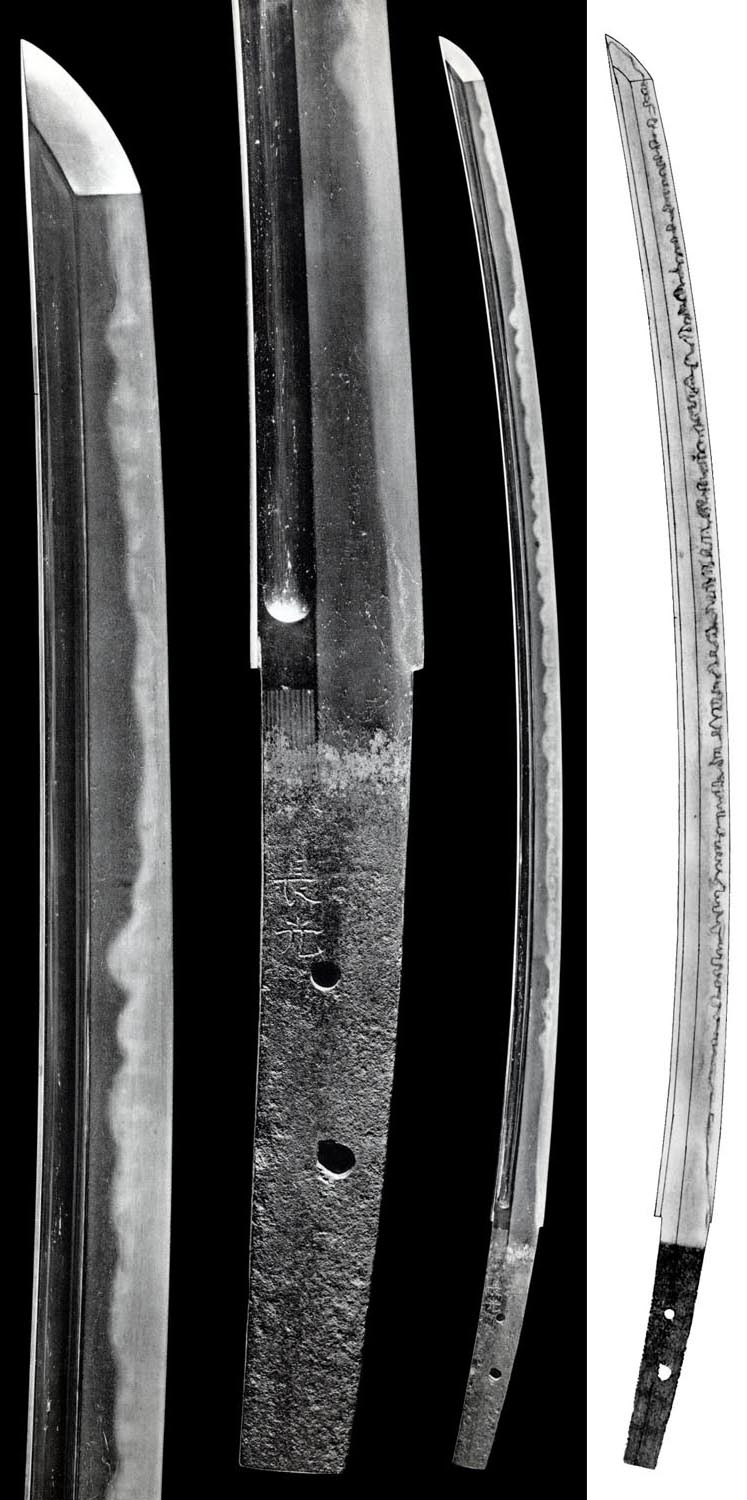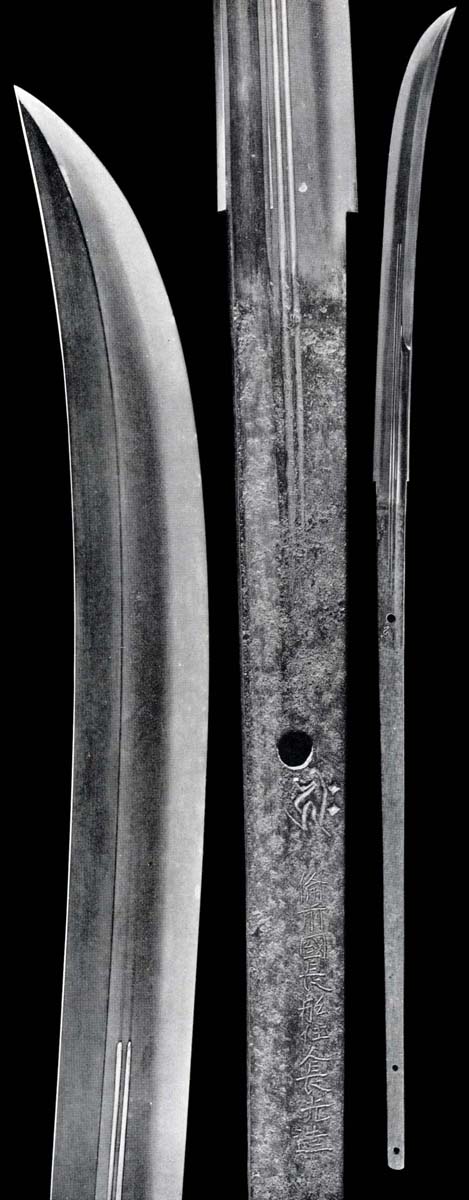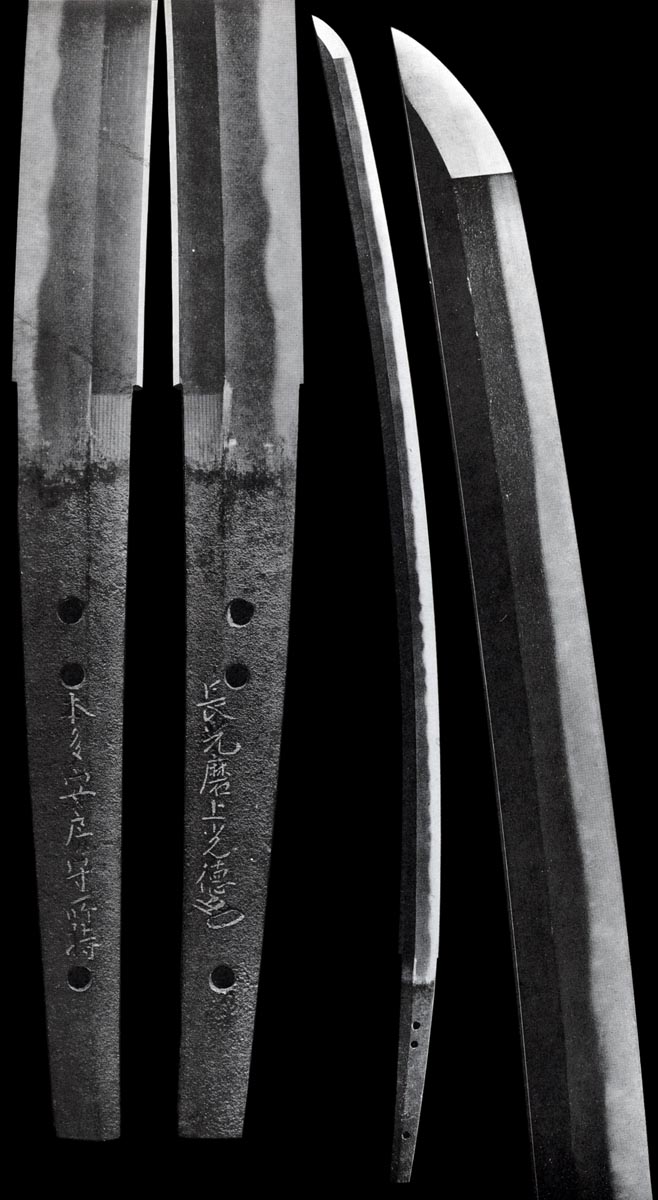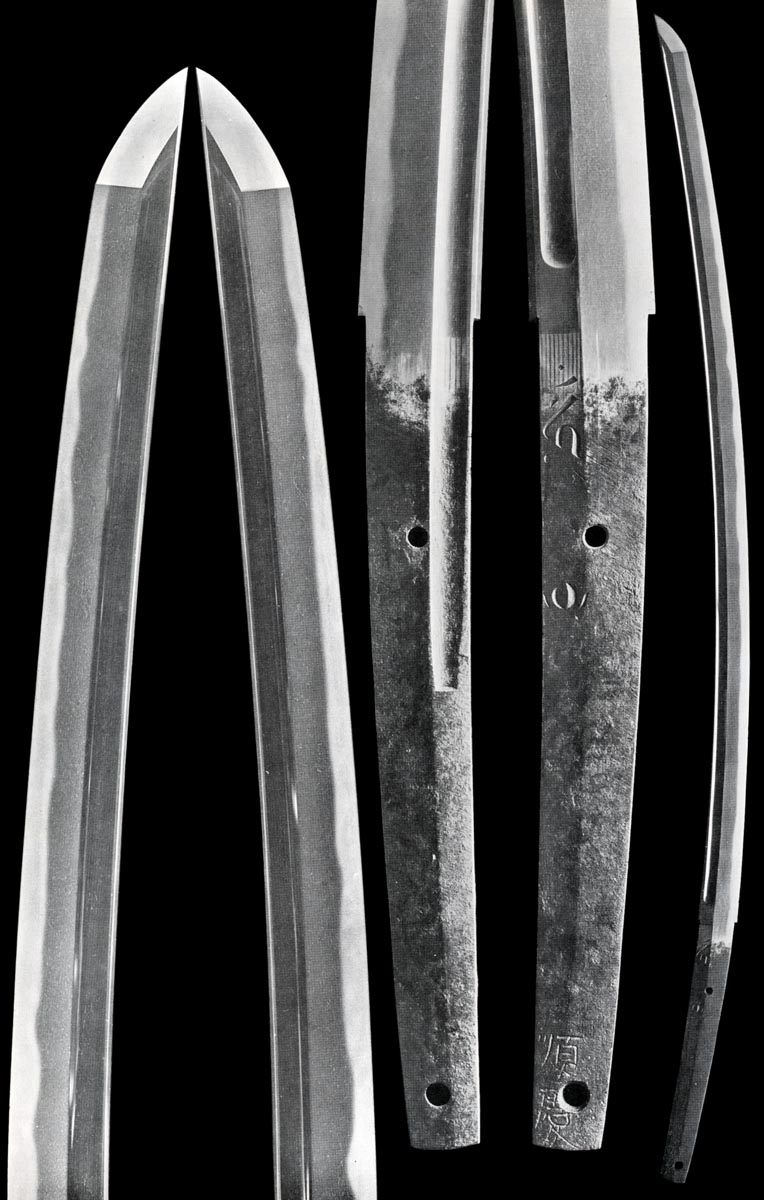| © Copyright Robert Cole 2015
- No copying or distributing BIZEN |
|
OSAFUNE NAGAMITSU and his SAN-SAKU "The Three Makers" NAGAMITSU - KAGEMITSU - SANENAGA - CHIKAKAGE -Showing NAGAMITSU "SAN-SAKU" BOSHI -Showing OSAFUNE MONOUCHI - CHU-width of less pattern -Showing CHOJI-UTSURI - may be spotty NAGAMITSU - GUNOME-CHOJI MIDARE BA with NIOI "Smoke" TOGARI Pattern has gentle undulations of height. KAGEMITSU - Leaning "Stooped Shoulders" GUNOME with SAKA-ASHI The pattern is somewhat even in height. CHIKAKAGE - Gently undulating KO-GUNOME with ASHI or CHOJI BA SANENAGA - Tight NIOI SUGUHA of KO-MIDARE or KO-CHOJI SAKA-ASHI _________ MITSUTADA RYAKU-NIN 1238 |______________________ _____________________ ___|_____ ___|____ ___|____ NAGAMITSU SHO-O 1288 KAGEYASU SHO-O 1288 SANENAGA KA-GEN 1303 |___________________ _____________ _______________ __________ ___|_____ ___|____ ___|_____ ___|______ | KAGEMITSU(1) MORITADA SANEMITSU(1) SHIGEMITSU(1) | | GEN-KYO 1321 GEN-KO 1331 | SHO-O 1288 ___|_____ | | _____________ ____________| NAGAMITSU(3) | | ____|_____ ___|_____ ___|_____ | | TOSHIMITSU MITSUNAGA SANEMITSU(2) SHO-KEI 1332 | | GEN-KYO 1321 EN-BUN 1356 ___|_____ | | See following SANEMITSU(3) MEI-TOKU 1390 | | _______________________ _________________ ___| | ___|____ ___|_____ ________|____ | KAGEMASA BUN-PO 1317 NAGACHIKA RAI MITSUKANE | ___|_____ GEN-KYO 1321 See OMI | CHIKAKAGE(1) GEN-O 1319 | _________|______________ __________ | ___|____ ___|_____ ____|____ ____|____ | HIDEKAGE CHIKAKAGE(2) CHIKAMUNE YOSHIKAGE(1) KEM-MU 1334 | ___|_____ - TEI-WA 1345 - |_________________ | SHIGEHIDE __________|____ _____|___ | MEI-TOKU 1390 KOZORI IYESHIGE YOSHIKANE |_________________________ KO-RYAKU 1379 MEI-TOKU 1390 ___|_______ ___|_____ O-KANEMITSU KEM-MU 1334 KAGEMITSU(2) KEM-MU 1334 ___|_____ ___|_____ YOSHIKAGE(2) O-AN 1368 KAGEMITSU(3) O-AN 1368 ________ _________ ________ ________ NAGAMITSU Students: NAGAMOTO YOSHIMOTO NAGAMOTO NAGAKAGE - KO-AN 1278 - - SHO-AN 1299 - _________ _________ ________ _________ ________ _________ HISAMITSU MUNEMITSU(1) IYEMITSU NORIMITSU NAGAMUNE YOSHITADA - SHO-WA 1312 - (f: TADASADA) ________ ________ _________ MUNENAGA NAGAMORI TOSHIMUNE - BUN-PO 1317 - SHO-CHU 1324 |
NAGAMITSU(1) KEN-CHO (f: MITSUTADA): Often recorded working dates give: BUN-EI 1264, KO-AN 1278 and SHO-O 1288. Most NAGAMITSU MEI appear from BUN-EI 1264 to GEN-O 1319. NAGAMITSU(1): Born: TEI-O 1222, Died EI-NIN 5, 1297 with following work belonging to coming generations. SAEMON-JO. His fame and reputation earned SAKON SHOGEN and he is thought to have signed JUNKEI in retirement. Early work resembles father, MITSUTADA with large patterned O-CHOJI MIDARE BA on mid-KAMAKURA wide upper and full IKUBI-KISSAKI. Later: NAGAMITSU blades lose their powerful KEN-CHO upper for the graceful FUNBARI of the mid/late KAMAKURA SUGATA transition. Time lessens his emphasis from MITSUTADA-style YAKIBA undulation to a more subtle variation in height. GUNOME makes its KO-AN 1278 appearance, interdicting the mid-KAMAKURA O-CHOJI patterns popular of the ICHIMONJI and MITSUTADA's KAWAZU. Note: The OSAFUNE, KO-AN GUNOME style-innovation became vogue throughout the country, spreading to SOSHU with popularists such as SABURO KUNIMUNE. Mark: GUNOME juts and boulders push through KO-CHOJI. SUGATA: Raised SHINOGI TACHI are most encountered. Mid-KAMAKURA strength resolves to the graceful transition-period FUNBARI. KO-DACHI and KEN are rare. MU-SORI TANTO are attributed as late work. Steel: Refined KO-ITAME has O-HADA. NAGAMITSU and his school, KAGEMITSU, SANENAGA and CHIKAKAGE, etc. will show standing MIDARE-UTSURI, the OSAFUNE special mark. UTSURI may spot in BOTAN "Peony" UTSURI or join and dance as CHOJI-UTSURI. CHOJI-UTSURI? - Think NAGAMITSU. OSAFUNE MONOUCHI: YAKIBA line descends from pattern to a fairly deserted KO-MIDARE or KO-CHOJI defined of ASHI where the tops hold together on a slightly varying CHU-width. BOSHI: Early: CHOJI-MIDARE or MIDARE-KOMI. Later: SAN-SAKU BOSHI, a style seen in and named for his "Three Makers." The SAN-SAKU: YAKIBA dips toward the edge just above the YOKOTE, then widens in a bump which thins and may take a smaller, second bump before a small KO-MARU. MEI: NAGAMITSU OSAFUNE NAGAMITSU BIZEN-no-KUNI OSAFUNE JU NAGAMITSU BIZEN-no-KUNI OSAFUNE JUNIN SAKON NAGAMITSU TSUKURU BIZEN-no-KUNI OSAFUNE JU SAKON SHOGEN NAGAMITSU TSUKURU NAGAMITSU Recap: Early: Strong, mid-KAMAKURA SUGATA. Undulating O-CHOJI MIDARE BA. Later: Graceful mid/late KAMAKURA transition FUNBARI SUGATA. Less undulation to GUNOME-CHOJI BA. NAGAMITSU also seen in KEM-MU 1334, SHO-HEI 1346, O-EI 1394, BUN-MEI 1469, EI-SHO 1504, EI-ROKU 1558 and BUN-ROKU 1592. |
KOKUHO DAIHANNYA

|
 NAGASA: 78.0cm SORI: 2.9cm Signed in reverence of NAGAMITSU's religious affiliation, akin to his Guardian Deity, the KUMANO SHINKO. The three KUMANO-no-SANZAN, HONGU, SHINGU and NACHI, along the KUMANO River in KII, are the most sacred SHINTO Shrines devoted to the Creation Mysteries. SHINOGI-TSUKURI, IHORI-MUNE, KOSHIZORI. FUNBARI TACHI slopes to a KO-KISSAKI. Tight KO-ITAME HADA has standing MIDARE-UTSURI. A defined NIOI-GUCHI draws the refined CHOJI-MIDARE with GUNOME of ASHI and YO of his late period work. NOTARE-KOMI BOSHI finds KO-MARU at the head. Falling UBU-NAKAGO resolves in a slightly HA-AGARI KURI-JIRI. Two MEKUGI-ANA. Signed
TACHI-MEI in the SHINOGI-JI: |
Nagamitsu
Naginata - Kokuho Nagamitsu Naginata - Kokuho Nagasa: 44.2cm Moto-Haba: 3.2cm Unokubi-Tsukuri Naginata with Naginata-Hi. Ko-Itame Hada has Ji-Nie and Midare-Utsuri. Gunome Choji-Midare mix. Hiro-Suguha in the Saki. Midare-Komi Boshi to Togari. Fukashi-Kaeri. Ubu Kurijiri Naginata Nakago with three Mekugi-ana. Bonji - Bizen-no-Kuni Osafune Junin Nagamitsu Tsukuru |
Honda
Nagamitsu - Kokuho Honda Nagamitsu - Kokuho Nagasa: 75.5cm Moto-haba: 3cm Shinogi-Tsukuri, Ihori-Mune, deeply curved to elongated Chu-Kissaki. Ko-Itame Hada has profuse Ji-Nie and Chikei. Ko-Nie and Nioi-Fukashi Choji-Midare Ba has Ashi and Yo. Sunagashi attends while Nie is more pronounced in the upper. Midare-Komi Boshi with slight Kaeri. O-Suriage Nakago has three Mekugi-ana and Kinzogan attribution. Nagamitsu Suriage Kotoku - Cao Honda Yasufusa-no-Kami Shoji |
Nagamitsu
Ken - Kokuho
|
|
Junkei
- Kokuho Junkei - Kokuho Nagasa: 69.4cm Moto-haba: 2.9cm Shinogi-Tsukuri, Ihori-Mune, deep Sori to Chu-Kissaki. Bo-Hi both sides. Maru-Dome above Bonji and Rendai Lotus on Omote and Kaku-Dome, Ura. Ko-Itame Hada has Ji-Nie. Ko-Nie Deki Ko-Midare Ba with Ashi-iri. Asaku Notare-Komi Maru Boshi. Suriage Nakago has two Mekugi-ana. Signed across the Shinogi in the lower. Junkei |
Junkei
- Kokuho Junkei - Kokuho Nagasa: 66,8cm Moto-Haba: 2.9cm Shinogi-Tsukuri, Ihori-Mune, deeply curved to Chu-Kissaki. Itame Hada has thin Ji-Nie. Nioi-Fukashi and Ko-Nie Deki Gunome Choji-Midare Ba with Ashi-iri, Sunagashi and Kinsuji. Omote Midare-Komi, Ura Notare Boshi. Ubu Nakago has two Mekugi-ana. Signed across the Shinogi in the upper. Junkei |
JUNKEI KO-AN: To EI-NIN 1293. Traditionally this was NAGAMITSU's priest or retirement name. The evidence is similarity of GUNOME within CHOJI showing TOGARI in the tops and a vividly clear MIDARE-UTSURI. The signatures, however, differ in style, among other documented doubts. In any event, NAGAMITSU and JUNKEI are closely akinned. JUNKEI: Made TACHI SUGATA. KO-ITAME has a thin JI-NIE veil and standing MIDARE-UTSURI. CHOJI-MIDARE or KO-MIDARE of KO-GUNOME with TOGARI in KO-NIE. BOSHI is CHU-MARU HAKIKAKE or YAKIZUME. NAGAMOTO SHO-AN (t: NAGAMITSU): Helped his master in NAGAMITSU's declining years. HADA with MIDARE-UTSURI. KO-CHOJI MIDARE - GUNOME mix. SAN-SAKU BOSHI. NAGAMOTO OSAFUNE JU NAGAMOTO SAKU BIZEN-no-KUNI OSAFUNE JU NAGAMOTO TAMEMUNE(1) GEN-KYO (f: NAGAMOTO): MOKUME HADA. CHOJI BA. 2nd to KOZORI. See KOZORI BISHU OSAFUNE TAMEMUNE NAGAMITSU(2) KO-AN (f: NAGAMITSU): SAKON SHOGEN. The title is synonymous for NAGAMITSU(2) with many statements that (1) did not use it. Born: KEN-CHO 1249, Died: SHO-WA 5, 1316. MOKUME. NIOI-DEKI MIDARE and CHOJI-MIDARE BA. OSAFUNE MONOUCHI: KO-MIDARE or KO-CHOJI defined of ASHI-IRI. BIZEN-no-KUNI SAKON SHOGEN NAGAMITSU TSUKURU SHIGEMITSU(1) O-CHO (f: NAGAMITSU): Considered with KAGEMITSU. See KAGEMITSU School NAGAMITSU(3) SHO-HEI (f: SHIGEMITSU): BIZEN-no-KUNI NAGAMITSU KAGEMASA BUN-PO (f: NAGAMITSU, br: KAGEMITSU): SHINSHI-ZABURO. UEMONnoJO. Swords much like his brother, KAGEMITSU. See KAGEMITSU School |
|